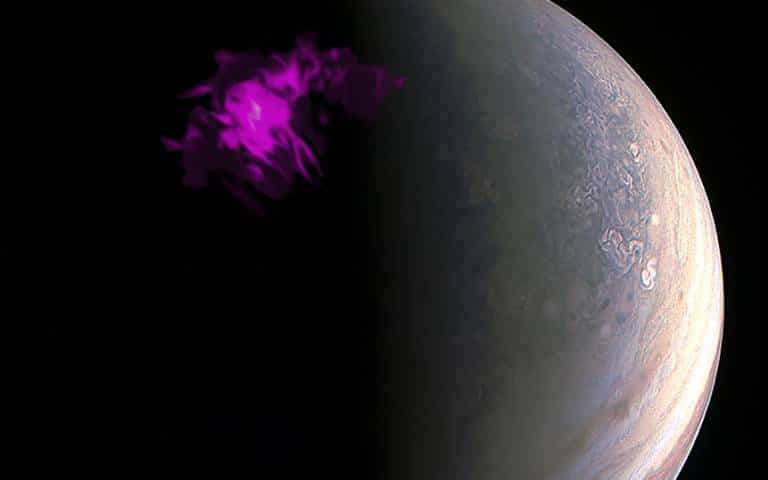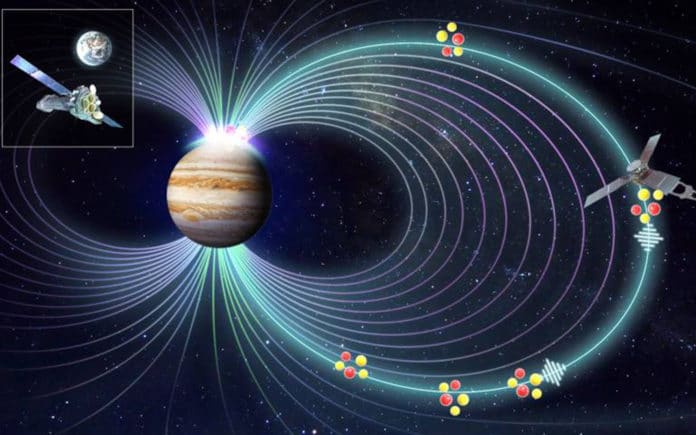Massive amounts of energy swirling over Jupiter’s polar regions have been observed. This energy is believed to prompt the giant planet’s powerful auroras. However, Jupiter’s auroras present a powerful mystery.
Jupiter has the most powerful auroras in the solar system: they alone release about gigawatt energy, yet how Jupiter produces a spectacular burst of X-rays every few minutes remains mysterious.
Now, this 40-year old Jupiter’s northern lights mystery has been solved by a research team co-led by UCL (University College London) and the Chinese Academy of Sciences.
In a new study, scientists combined close-up observations of Jupiter’s environment by NASA’s satellite Juno with simultaneous X-ray measurements from the European Space Agency’s XMM-Newton observatory.
Scientists discovered that periodic vibrations of Jupiter’s magnetic field lines trigger those x-ray flares. These vibrations create plasma waves that send heavy ion particles “surfing” along magnetic field lines until they smash into the planet’s atmosphere, releasing energy in the form of X-ray auroras.
These heavy ion particles are originated from ionized volcanic gas pouring into space from giant volcanoes on Jupiter’s moon, Io. The collisions in Jupiter’s immediate environment create this ionized gas that forms a donut of plasma surrounding the planet.
These X-ray auroras occur at Jupiter’s south pole and north pole every 27 minutes.
Co-lead author Dr. William Dunn (UCL Mullard Space Science Laboratory) said: “We have seen Jupiter producing X-ray aurora for four decades, but we didn’t know how this happened. We only knew they were produced when ions crashed into the planet’s atmosphere.”
“Now we know these ions are transported by plasma waves – an explanation that has not been proposed before, even though a similar process produces Earth’s aurora. It could, therefore, be a universal phenomenon, present across many different environments in space.”
Co-lead author Dr. Zhonghua Yao (Chinese Academy of Sciences, Beijing) said: “Now we have identified this fundamental process, there is a wealth of possibilities for where it could be studied next. Similar processes likely occur around Saturn, Uranus, Neptune, and probably exoplanets as well, with different kinds of charged particles’ surfing’ the waves.”
Co-author Professor Graziella Branduardi-Raymont (UCL Mullard Space Science Laboratory) said: “X-rays are typically produced by compelling and violent phenomena such as black holes and neutron stars, so it seems strange that mere planets produce them too.”
“We can never visit black holes, as they are beyond space travel, but Jupiter is on our doorstep. With the arrival of the satellite Juno into Jupiter’s orbit, astronomers now have a fantastic opportunity to study an environment that produces X-rays up close.”
For the new examination, scientists studied observations of Jupiter and its surrounding environment completed consistently over a 26-hour time frame by the Juno and XMM-Newton satellites.
They found a clear relationship between’s waves in the plasma identified by Juno and X-ray auroral flares at Jupiter’s north pole recorded by X-MM Newton.
Using computer modeling, it was confirmed that the waves would drive the heavy particles towards Jupiter’s atmosphere.

However, the reason behind the vibrations of magnetic field lines remains unclear. In Jupiter’s magnetosphere, the vibration may result from interactions with the solar wind or high-speed plasma flows.
The work was supported by the Chinese Academy of Sciences, the National Natural Science Foundation of China, the UK’s Science and Technology Facilities Council (STFC), the Royal Society, Natural Environment Research Council, and ESA and NASA.
Journal Reference:
- Zhonghua Yao et al. Revealing the source of Jupiter’s x-ray auroral flares. DOI: 10.1126/sciadv.abf0851
